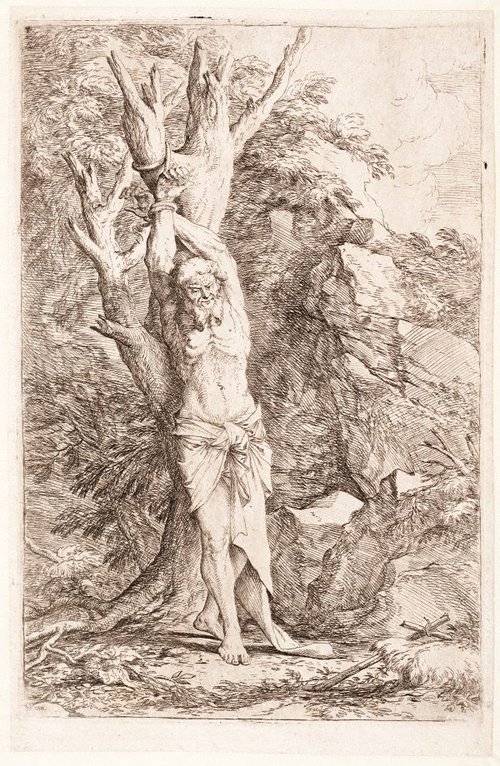-
Details
- Date
- circa 1662
- Media category
- Materials used
- etching and drypoint
- Edition
- iii of 3 states
- Dimensions
- 45.7 x 27.6 cm platemark (irreg.); 52.9 x 39.4 cm sheet (irreg.)
- Signature & date
Not signed. Not dated.
- Credit
- Purchased 1979
- Location
- Not on display
- Accession number
- 230.1979
- Copyright
- Artist information
-
Salvator Rosa
Works in the collection
- Share
-
-
About
‘Sincere, free, fiery painter and equable, despiser of wealth and death, this is my genius.’ So proclaims the scroll in the lower-right corner of this etching, Rosa’s most emphatic expression of his artistic philosophy. As well as being a painter and etcher, Rosa was also an actor, musician and poet, famous (some would say infamous) in his day as a flamboyant and outspoken artistic personality who believed utterly in the dignity of creative genius and the freedom of the artist to pursue his own path, irrespective of the demands of patronage or convention at large.
Early biographers, such as Filippo Baldinucci, who knew Rosa well, described his fiery character and burning ambition, and how he often made enemies with painters and potential patrons alike. The radically original nature of Rosa’s views on the necessary independence of the artist and the primacy of creative inspiration anticipate ideas that were to become current with the Romantic movement of the late 18th and early 19th centuries. Indeed, by this time Rosa had come to be seen as a precursor of the Romantic hero – a reputation no doubt nurtured by myths of his upbringing among bandits in his native Naples and of his fighting there against Spanish rule. His landscape paintings of wild and mountainous scenery, populated with travellers and banditti, were highly appreciated in 18th-century Britain and helped define the Romantic sublime in external nature. Horace Walpole memorably noted when crossing the Alps in 1739: ‘Precipices, mountains, torrents, wolves, rumblings – Salvator Rosa.’
More than a landscape painter, Rosa desired to be known as a learned painter of histories and allegories. After almost a decade in Florence, an experience that left him dissatisfied, Rosa returned to Rome in 1649 and began working on a series of large-scale figure compositions with serious philosophical and moralising themes. In the early 1660s he produced a number of classicising etchings, which developed the erudite subject matter of his paintings and reflected the artist’s interest in Stoicism, with its scorn of fortune and the worldly life.
The genius of Salvator Rosa illustrates the artist’s philosophical motto virtually to the letter. The artist/genius figure is depicted as a youth crowned with ivy and reclining in the pose of a classical river god; his left arm rests on an overturned cornucopia spilling coins and jewels, however he appears uninterested in these riches. Likewise, the cemetery setting, with its cypress trees, prominent tomb and large vase decorated with a goat’s skull and emitting smoke, suggests the artist’s indifference to and repudiation of mortality.
Surrounding the youth are five allegorical figures whose attributes represent various facets of genius to which Rosa aspired. The youth offers his heart to the personification of Sincerity, represented by the woman holding a dove. Directly behind him, Liberty places a cap on his head. In the left foreground, the kneeling woman holding a panel with a figure sketched on it is Painting. The philosopher-type wearing a toga and gesturing to his book and balance represents the idea of equability and fairness. In stark contrast to all of them, a coarse satyr (herself crowned with ivy like the main figure) represents the baser instincts. More importantly, satyrs were linked with satire, a mode of writing at which Rosa excelled, mercilessly holding up human vice and folly to scorn and ridicule.
Peter Raissis, Prints & drawings Europe 1500–1900, 2014
-
Exhibition history
Shown in 6 exhibitions
The Bitten Image: European etchings from the collection, Art Gallery of New South Wales, Sydney, 19 Jul 1980–14 Sep 1980
Three years on: acquisitions 1978-81, Art Gallery of New South Wales, Sydney, 15 Oct 1981–01 Dec 1981
Piety and Paganism, Art Gallery of New South Wales, Sydney, 13 Jul 1991–29 Sep 1991
Mantegna to Piranesi - Italian Old Master Prints from the Collection of the Art Gallery of New South Wales, Art Gallery of New South Wales, Sydney, 27 Jun 1998–20 Sep 1998
Old Europe: Prints & drawings from the collection 1500-1800, Art Gallery of New South Wales, Sydney, 03 Jun 2006–06 Aug 2006
European prints and drawings 1500-1900, Art Gallery of New South Wales, Sydney, 30 Aug 2014–02 Nov 2014
-
Bibliography
Referenced in 7 publications
-
Nicholas Draffin (Curator), The bitten image: European etchings from the collection, Sydney, 1980, p 4. no catalogue numbers
-
Nicholas Draffin, Piety and Paganism, Sydney, 1991, p 10. no catalogue numbers
-
Nicolas Draffin, Three years on: a selection of acquisitions 1978-1981, 'Prints and Drawings - Australia, European and American', pg. 47-66, Sydney, 1981, illus p 58. cat.no. 23
-
Peter Raissis, Prints & drawings Europe 1500-1900, Sydney, 2014, p 70, col illus p 71.
-
Peter Raissis, Mantegna to Piranesi - Italian old master prints from the collection of the Art Gallery of New South Wales, Sydney, 1998, 5, 8. no catalogue numbers
-
Adam von Bartsch, Le peintre graveur [21 vols], Vienna, 1803-1821, vol XX, p 277. no 24
-
Richard Wallace, The etchings of Salvator Rosa, 1979, pp 79-92, pp 289-93. no 113
-




